Design of New α-Conotoxins: From Computer Modeling to Synthesis of Potent Cholinergic Compounds
Abstract
:1. Introduction
2. Results and Discussion
2.1. Computer Modeling and Choice of Amino Acid Substitutions
2.2. Preparation of Synthetic α-Conotoxin Analogs
2.3. Binding Assays with α-Conotoxin Analogs
Competition Radioligand Assay with [125I]-Labeled α-Bungarotoxin
2.4. Experiments with Radioactive Forms of α-Conotoxin Analogs
2.4.1. Preparation of Radioactive Derivatives
2.4.2. Direct Radioligand Assay
2.4.3. Competition Radioligand Assay with [125I]-Labeled Derivatives of α-Conotoxins
3. Experimental Section
3.1. Computer Modeling
3.2. Peptide Synthesis
3.3. Iodination
3.4. Radioligand Assay
4. Conclusions
Acknowledgements
- Samples Availability: Available from the authors.
References
- Celie, PHN; Kasheverov, IE; Mordvintsev, DY; Hogg, RC; van Nierop, P; van Elk, R; van Rossum-Fikkert, SE; Zhmak, MN; Bertrand, D; Tsetlin, V; et al. Crystal structure of nicotinic acetylcholine receptor homolog AChBP in complex with an α-conotoxin PnIA variant. Nat. Struct. Mol. Biol 2005, 12, 582–588. [Google Scholar]
- Nicke, A; Wonnacott, S; Lewis, RJ. α-Conotoxins as tools for the elucidation of structure and function of neuronal nicotinic acetylcholine receptor subtypes. Eur. J. Biochem 2004, 271, 2305–2319. [Google Scholar]
- Janes, RW. α-Conotoxins as selective probes for nicotinic acetylcholine receptor subclasses. Curr. Opin. Pharmacol 2005, 5, 280–292. [Google Scholar]
- Olivera, BM; Quik, M; Vincler, M; McIntosh, M. Subtype-selective conopeptides targeted to nicotinic receptors. Channels 2008, 2, 143–152. [Google Scholar]
- Azam, L; McIntosh, JM. α-Conotoxins as pharmacological probes of nicotinic acetylcholine receptors. Acta Pharmacol. Sin 2009, 30, 771–783. [Google Scholar]
- Vincent, A; Beeson, D; Lang, B. Molecular targets for autoimmune and genetic disorders of neuromuscular transmission. Eur. J. Biochem 2000, 267, 6717–6728. [Google Scholar]
- O’Neill, MJ; Murray, TK; Lakics, V; Visanji, NP; Duty, S. The role of neuronal nicotinic acetylcholine receptors in acute and chronic neurodegeneration. Curr. Drug Targets CNS Neurol. Disord 2002, 1, 399–411. [Google Scholar]
- Steinlein, OK. Nicotinic receptor mutations in human epilepsy. Prog. Brain Res 2004, 145, 275–285. [Google Scholar]
- Livett, BG; Sandall, DW; Keays, D; Down, J; Gayler, KR; Satkunanathan, N; Khalil, Z. Therapeutic applications of conotoxins that target the neuronal nicotinic acetylcholine receptor. Toxicon 2006, 48, 810–829. [Google Scholar]
- Lewis, RJ. Conotoxin venom peptide therapeutics. Adv. Exp. Med. Biol 2009, 655, 44–48. [Google Scholar]
- Kasheverov, IE; Utkin, YN; Tsetlin, VI. Naturally occurring and synthetic peptides acting on nicotinic acetylcholine receptors. Curr. Pharm. Des 2009, 15, 2430–2452. [Google Scholar]
- Dineley, KT. β-Amyloid peptide—nicotinic acetylcholine receptor interaction: The two faces of health and disease. Front. Biosci 2007, 12, 5030–5038. [Google Scholar]
- Barrantes, FJ; Borroni, V; Vallés, S. Neuronal nicotinic acetylcholine receptor-cholesterol crosstalk in Alzheimer’s disease. FEBS Lett 2010, 584, 1856–1863. [Google Scholar]
- Johnson, DS; Martinez, J; Elgoyhen, AB; Heinemann, SF; McIntosh, JM. α-Conotoxin ImI exhibits subtype-specific nicotinic acetylcholine receptor blockade: Preferential inhibition of homomeric α7 and α9 receptors. Mol. Pharmacol 1995, 48, 194–199. [Google Scholar]
- Pereira, EF; Alkondon, M; McIntosh, JM; Albuquerque, EX. α-Conotoxin-ImI: A competitive antagonist at α-bungarotoxin-sensitive neuronal nicotinic receptors in hippocampal neurons. J. Pharmacol. Exp. Ther 1996, 278, 1472–1483. [Google Scholar]
- Broxton, NM; Down, JG; Gehrmann, J; Alewood, PF; Satchell, DG; Livett, BG. α-Conotoxin ImI inhibits the α-bungarotoxin-resistant nicotinic response in bovine adrenal chromaffin cells. J. Neurochem 1999, 72, 1656–1662. [Google Scholar]
- Ellison, M; Gao, F; Wang, HL; Sine, SM; McIntosh, JM; Olivera, BM. α-Conotoxins ImI and ImII target distinct regions of the human α7 nicotinic acetylcholine receptor and distinguish human nicotinic receptor subtypes. Biochemistry 2004, 43, 16019–16026. [Google Scholar]
- Hogg, RC; Miranda, LP; Craik, DJ; Lewis, RJ; Alewood, PF; Adams, DJ. Single amino acid substitutions in α-conotoxin PnIA shift selectivity for subtypes of the mammalian neuronal nicotinic acetylcholine receptor. J. Biol. Chem 1999, 274, 36559–36564. [Google Scholar]
- Luo, S; Nguyen, TA; Cartier, GE; Olivera, BM; Yoshikami, D; McIntosh, JM. Single-residue alteration in α-conotoxin PnIA switches its nAChR subtype selectivity. Biochemistry 1999, 38, 14542–14548. [Google Scholar]
- Smit, AB; Syed, NI; Schaap, D; van Minnen, J; Klumperman, J; Kits, KS; Lodder, H; van der Schors, RC; van Elk, R; Sorgedrager, B; et al. A glia-derived acetylcholine-binding protein that modulates synaptic transmission. Nature 2001, 411, 261–268. [Google Scholar]
- Hansen, SB; Talley, TT; Radic, Z; Taylor, P. Structural and ligand recognition characteristics of an acetylcholine-binding protein from Aplysia californica. J. Biol. Chem 2004, 279, 24197–24202. [Google Scholar]
- Hansen, SB; Sulzenbacher, G; Huxford, T; Marchot, P; Taylor, P; Bourne, Y. Structures of Aplysia AChBP complexes with nicotinic agonists and antagonists reveal distinctive binding interfaces and conformations. EMBO J 2005, 24, 3635–3646. [Google Scholar]
- Ulens, C; Hogg, RC; Celie, PH; Bertrand, D; Tsetlin, V; Smit, AB; Sixma, TK. Structural determinants of selective α-conotoxin binding to a nicotinic acetylcholine receptor homolog AChBP. Proc. Natl. Acad. Sci. USA 2006, 103, 3615–3620. [Google Scholar]
- Dutertre, S; Ulens, C; Büttner, R; Fish, A; van Elk, R; Kendel, Y; Hopping, G; Alewood, PF; Schroeder, C; Nicke, A; et al. AChBP-targeted α-conotoxin correlates distinct binding orientations with nAChR subtype selectivity. EMBO J 2007, 26, 3858–3867. [Google Scholar]
- Hu, SH; Gehrmann, J; Guddat, LW; Alewood, PF; Craik, DJ; Martin, JL. The 1.1 Å crystal structure of the neuronal acetylcholine receptor antagonist, α-conotoxin PnIA from Conus pennaceus. Structure 1996, 4, 417–423. [Google Scholar]
- Hu, SH; Gehrmann, J; Alewood, PF; Craik, DJ; Martin, JL. Crystal structure at 1.1 Å resolution of α-conotoxin PnIB: Comparison with α-conotoxins PnIA and GI. Biochemistry 1997, 36, 11323–11330. [Google Scholar]
- Kasheverov, IE; Zhmak, MN; Vulfius, CA; Gorbacheva, EV; Mordvintsev, DY; Utkin, YN; van Elk, R; Smit, AB; Tsetlin, VI. α-Conotoxin analogs with additional positive charge show increased selectivity towards Torpedo californica and some neuronal subtypes of nicotinic acetylcholine receptors. FEBS J 2006, 273, 4470–4481. [Google Scholar]
- Kasheverov, IE; Chiara, DC; Zhmak, MN; Maslennikov, IV; Pashkov, VS; Arseniev, AS; Utkin, YN; Cohen, JB; Tsetlin, VI. α-Conotoxin GI benzoylphenylalanine derivatives: 1H-NMR structures and photoaffinity labeling of the Torpedo californica nicotinic acetylcholine receptor. FEBS J 2006, 273, 1373–1388. [Google Scholar]
- Mordvintsev, DY; Polyak, YL; Levtsova, OV; Tourleigh, YV; Kasheverov, IE; Shaitan, KV; Utkin, YN; Tsetlin, VI. A model for short α-neurotoxin bound to nicotinic acetylcholine receptor from Torpedo californica: Comparison with long-chain α-neurotoxins and α-conotoxins. Comput. Biol. Chem 2005, 29, 398–411. [Google Scholar]
- Bourne, Y; Talley, TT; Hansen, SB; Taylor, P; Marchot, P. Crystal structure of a Cbtx-AChBP complex reveals essential interactions between snake α-neurotoxins and nicotinic receptors. EMBO J 2005, 24, 1512–1522. [Google Scholar]
- Unwin, N. Refined structure of the nicotinic acetylcholine receptor at 4 Å resolution. J. Mol. Biol 2005, 346, 967–989. [Google Scholar]
- Ellison, M; McIntosh, JM; Olivera, BM. α-Conotoxins ImI and ImII. Similar α7 nicotinic receptor antagonists act at different sites. J. Biol. Chem 2003, 278, 757–764. [Google Scholar]
- Ellison, M; Haberlandt, C; Gomez-Casati, ME; Watkins, M; Elgoyhen, AB; McIntosh, JM; Olivera, BM. α-RgIA: A novel conotoxin that specifically and potently blocks the α9α10 nAChR. Biochemistry 2006, 45, 1511–1517. [Google Scholar]
- Ellison, M; Feng, ZP; Park, AJ; Zhang, X; Olivera, BM; McIntosh, JM; Norton, RS. α-RgIA, a novel conotoxin that blocks the α9α10 nAChR: Structure and identification of key receptor-binding residues. J. Mol. Biol 2008, 377, 1216–1227. [Google Scholar]
- Vincler, M; Wittenauer, S; Parker, R; Ellison, M; Olivera, BM; McIntosh, JM. Molecular mechanism for analgesia involving specific antagonism of α9α10 nicotinic acetylcholine receptors. Proc. Natl. Acad. Sci. USA 2006, 103, 17880–17884. [Google Scholar]
- McIntosh, JM; Dowell, C; Watkins, M; Garrett, JE; Yoshikami, D; Olivera, BM. α-Conotoxin GIC from Conus geographus, a novel peptide antagonist of nicotinic acetylcholine receptors. J. Biol. Chem 2002, 277, 33610–33615. [Google Scholar]
- McIntosh, JM; Plazas, PV; Watkins, M; Gomez-Casati, ME; Olivera, BM; Elgoyhen, AB. A novel α-conotoxin, PeIA, cloned from Conus pergrandis, discriminates between rat α9α10 and α7 nicotinic cholinergic receptors. J. Biol. Chem 2005, 280, 30107–30112. [Google Scholar]
- Talley, TT; Olivera, BM; Han, KH; Christensen, SB; Dowell, C; Tsigelny, I; Ho, KY; Taylor, P; McIntosh, JM. α-Conotoxin OmIA is a potent ligand for the acetylcholine-binding protein as well as α3β2 and α7 nicotinic acetylcholine receptors. J. Biol. Chem 2006, 281, 24678–24686. [Google Scholar]
- Kasheverov, I; Rozhkova, A; Zhmak, M; Utkin, Y; Ivanov, V; Tsetlin, V. Photoactivatable α-conotoxins reveal contacts with all subunits as well as antagonist-induced rearrangements in the Torpedo californica acetylcholine receptor. Eur. J. Biochem 2001, 268, 3664–3673. [Google Scholar]
- Kasheverov, IE; Zhmak, MN; Fish, A; Rucktooa, P; Khruschov, AY; Osipov, AV; Ziganshin, RH; D’hoedt, D; Bertrand, D; Sixma, TK; et al. Interaction of α-conotoxin ImII and its analogs with nicotinic receptors and acetylcholine-binding proteins: additional binding sites on Torpedo receptor. J. Neurochem 2009, 111, 934–944. [Google Scholar]
- Srivastava, S; Hamouda, AK; Pandhare, A; Duddempudi, PK; Sanghvi, M; Cohen, JB; Blanton, MP. [(3)H]Epibatidine photolabels non-equivalent amino acids in the agonist binding site of Torpedoα4β2 nicotinic acetylcholine receptors. J. Biol. Chem 2009, 284, 24939–24947. [Google Scholar]
- Brams, M; Pandya, A; Kuzmin, D; van Elk, R; Krijnen, L; Yakel, JL; Tsetlin, V; Smit, AB; Ulens, C. A structural and mutagenic blueprint for molecular recognition of strychnine and d-tubocurarine by different Cys-loop receptors. PLoS Biol 2011, 9, 1–12. [Google Scholar]
- Sali, A. MODELLER: Program for Comparative Protein Structure Modelling by Satisfaction of Spatial Restraints. Available online: http://salilab.org/modeller accessed on 10 February 2011.
- Arnold, K; Bordoli, L; Kopp, J; Schwede, T. The SWISS-MODEL Workspace: A web-based environment for protein structure homology modelling. Bioinformatics. 2006, 22, pp. 195–201. Available online: http://swissmodel.expasy.org accessed on 20 April 2011.
- The Official UCSF DOCK Website. Available online: http://dock.compbio.ucsf.edu accessed on 15 May 2011.
- Ritchie, D. Hex Protein Docking. Available online: http://www.csd.abdn.ac.uk/hex accessed on 15 May 2011.
- The Scripps Research Institute. AutoDock. Available online: http://autodock.scripps.edu accessed on 29 April 2011.
- Dominguez, C; Boelens, R; Bonvin, AMJJ. HADDOCK: a protein-protein docking approach based on biochemical and/or biophysical information. J Am Chem Soc. 2003, 125, pp. 1731–1737. Available online: http://www.nmr.chem.uu.nl/haddock accessed on 29 April 2011.
- Kasheverov, I; Zhmak, M; Chivilyov, E; Saez-Brionez, P; Utkin, Y; Hucho, F; Tsetlin, V. Benzophenone-type photoactivatable derivatives of α-neurotoxins and α-conotoxins in studies on Torpedo nicotinic acetylcholine receptor. J. Recept. Signal Transduct. Res 1999, 19, 559–571. [Google Scholar]
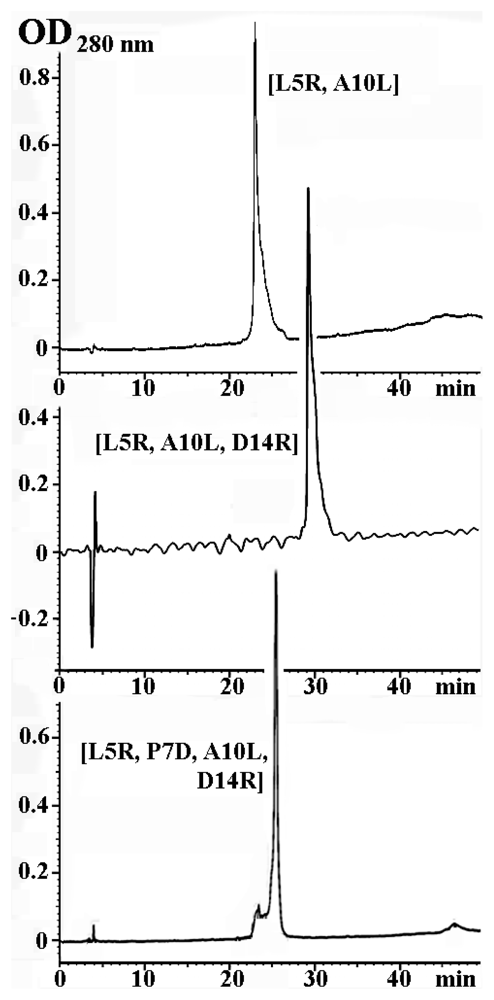
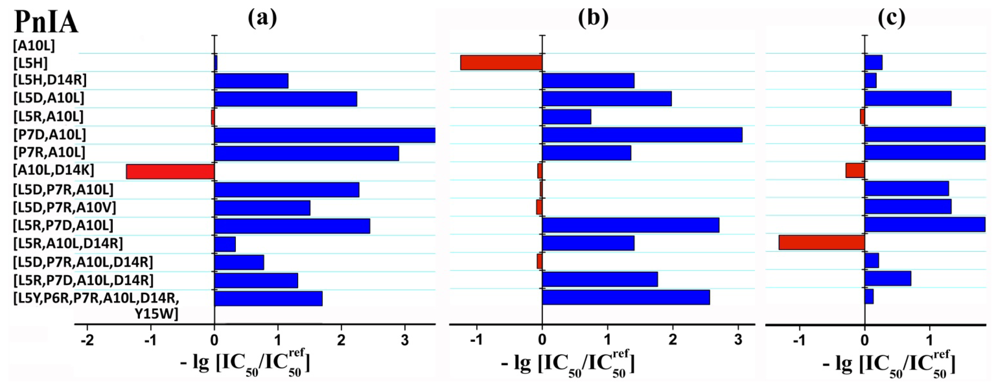

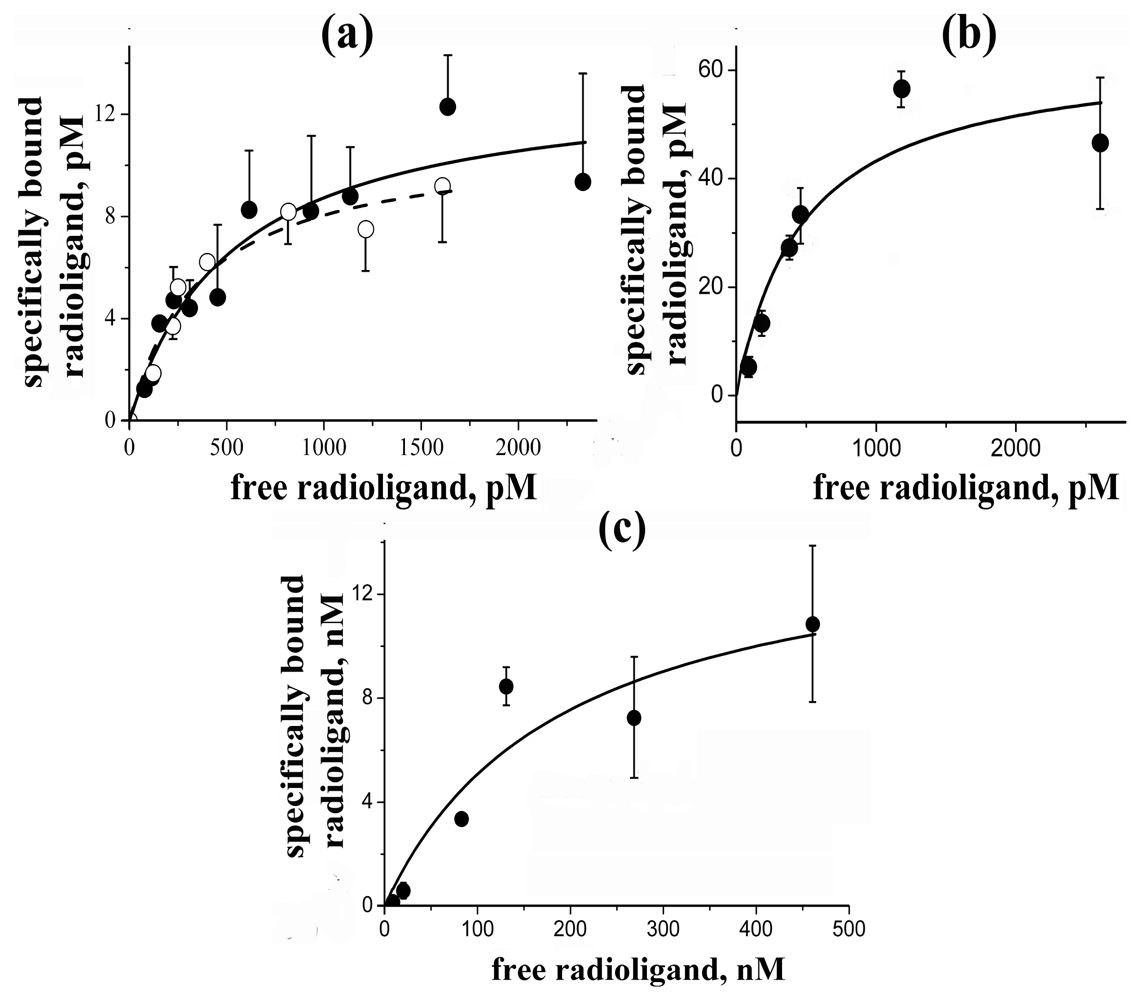
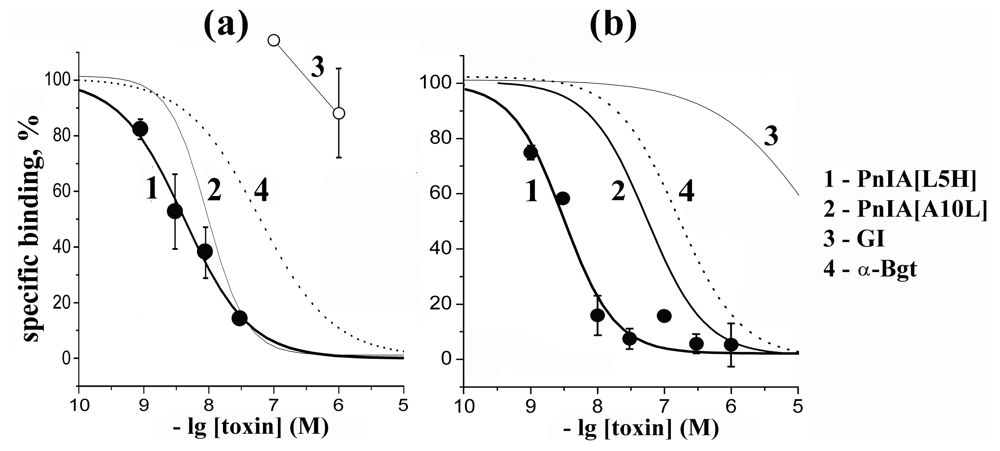
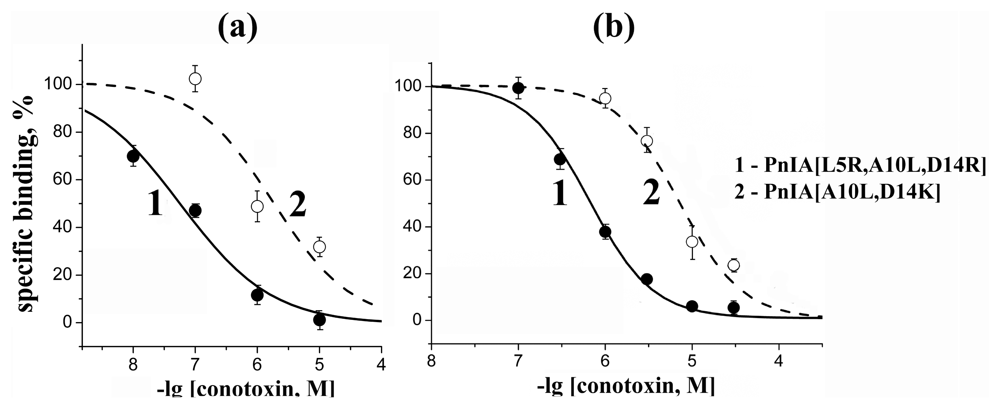
| Analogs of α-conotoxin PnIA | Sequences and mutations | Molecular masses | |
|---|---|---|---|
| Measured (MH+) | Calculated | ||
| PnIA | GCCSLPPCAANNPDYC-NH2 | - | - |
| PnIA[L5H] | GCCSHPPCAANNPDYC-NH2 | 1646.6 | 1645.6 |
| PnIA[L5H, D14R] | GCCSHPPCAANNPRYC-NH2 | 1687.3 | 1686.6 |
| PnIA[A10L] | GCCSLPPCALNNPDYC-NH2 | 1664.7 | 1663.7 |
| PnIA[L5D, A10L] | GCCSDPPCALNNPDYC-NH2 | 1666.7 | 1666.4 |
| PnIA[L5R, A10L] | GCCSRPPCALNNPDYC-NH2 | 1707.6 | 1706.6 |
| PnIA[P7D, A10L] | GCCSLPDCALNNPDYC-NH2 | 1682.4 | 1681.6 |
| PnIA[P7R, A10L] | GCCSLPRCALNNPDYC-NH2 | 1723.7 | 1722.9 |
| PnIA[A10L, D14K] | GCCSLPPCALNNPKYC-NH2 | 1677.6 | 1676.8 |
| PnIA[L5D, P7R, A10L] | GCCSDPRCALNNPDYC-NH2 | 1725.7 | 1724.9 |
| PnIA[L5D, P7R, A10V] | GCCSDPRCAVNNPDYC-NH2 | 1711.6 | 1710.8 |
| PnIA[L5R, P7D, A10L] | GCCSRPDCALNNPDYC-NH2 | 1725.4 | 1724.6 |
| PnIA[L5R, A10L, D14R] | GCCSRPPCALNNPRYC-NH2 | 1748.5 | 1747.7 |
| PnIA[L5D, P7R, A10L, D14R] | GCCSDPRCALNNPRYC-NH2 | 1766.7 | 1766.0 |
| PnIA[L5R, P7D, A10L, D14R] | GCCSRPDCALNNPRYC-NH2 | 1766.5 | 1765.7 |
| PnIA[L5Y, P6R, P7R, A10L, D14R, Y15W] | GCCSYRRCALNNPRWC-NH2 | 1896.8 | 1895.8 |
| Mutations in PnIA | IC50 in nM and Hill slopes (nH) in [125I]-αBgt displacement from | |||||
|---|---|---|---|---|---|---|
| L. stagnalis AChBP | A. californica AChBP | human α7 nAChR | ||||
| [L5H] | 220 ± 80 | (0.71 ± 0.06) | 3.1 ± 0.4 | (1.13 ± 0.15) | 26,000 ± 1000 | (1.15 ± 0.05) |
| [L5H, D14R] | 2900 ± 100 | (1.18 ± 0.05) | 1400 ± 100 | (1.31 ± 0.09) | 21,000 ± 1000 | (1.01 ± 0.05) |
| [A10L] | 200 ± 40 | (0.89 ± 0.13) | 55 ± 12 | (1.18 ± 0.24) | 14,000 ± 1000 | (0.73 ± 0.04) |
| [L5D, A10L] | 35,000 ± 3000 | (1.45 ± 0.20) | 5200 ± 1900 | (1.03 ± 0.17) | >100,000 | (−) |
| [L5R, A10L] | 180 ± 20 | (1.10 ± 0.10) | 305 ± 19 | (1.51 ± 0.25) | 12,000 ± 2000 | (1.03 ± 0.11) |
| [P7D, A10L] | >>100,000 | (−) | 63,000 ± 11,000 | (0.79 ± 0.11) | >>100,000 | (−) |
| [P7R, A10L] | >100,000 | (−) | 1250 ± 300 | (1.00 ± 0.23) | >>100,000 | (−) |
| [A10L, D14K] | 8.2 ± 1.2 | (1.01 ± 0.11) | 47 ± 9 | (0.77 ± 0.12) | 7200 ± 700 | (1.20 ± 0.11) |
| [L5D, P7R, A10L] | 38,000 ± 8000 | (0.69 ± 0.09) | 51 ± 11 | (1.38 ± 0.31) | >>100,000 | (−) |
| [L5D, P7R, A10V] | 6400 ± 1300 | (1.04 ± 0.22) | 45 ± 11 | (1.35 ± 0.42) | >100,000 | (−) |
| [L5R, P7D, A10L] | 56,000 ± 2000 | (1.48 ± 0.15) | 28,000 ± 4000 | (0.91 ± 0.09) | >>100,000 | (−) |
| [L5R, A10L, D14R] | 430 ± 90 | (1.20 ± 0.30) | 1400 ± 100 | (1.27 ± 0.16) | 670 ± 50 | (1.20 ± 0.19) |
| [L5D, P7R, A10L, D14R] | 1200 ± 250 | (0.73 ± 0.10) | 46 ± 8 | (1.44 ± 0.28) | 23,000 ± 1000 | (0.91 ± 0.13) |
| [L5R, P7D, A10L, D14R] | 4100 ± 200 | (1.25 ± 0.07) | 3200 ± 100 | (0.73 ± 0.12) | 72,000 ± 5000 | (0.84 ± 0.06) |
| [L5Y, P6R, P7R, A10L, D14R, Y15W] | 10,000 ± 1000 | (1.09 ± 0.05) | 20,000 ± 2000 | (1.26 ± 0.18) | 19,000 ± 1000 | (1.20 ± 0.26) |
| Compound | IC50 in nM and Hill slopes (nH) in competition with | |||
|---|---|---|---|---|
| [125I]-PnIA[L5H] | [125I]-αBgt | |||
| PnIA[L5H] | 4.2 ± 0.3 | (0.87 ± 0.05) | 3.1 ± 0.4 | (1.13 ± 0.15) |
| PnIA[A10L] | 9.5 ± 1.1 | (1.40 ± 0.20) | 36–55 * | |
| PnIA[A10L, D14K] | 2.2 ± 0.6 | (1.42 ± 0.49) | 28–47 * | |
| α-conotoxin ImI | 0.84 ± 0.15 | (1.37 ± 0.29) | 33 ± 5 ** | |
| α-conotoxin GI | >>1000 | (−) | 25,500 ± 6300 ** | |
| α-bungarotoxin (αBgt) | 60 ± 10 | (0.77 ± 0.08) | 130 ± 20 ** | |
| Compound | IC50 in nM and Hill slopes (nH) in competition with | |||
|---|---|---|---|---|
| [125I]-PnIA[L5R, A10L, D14R] | [125I]-αBgt | |||
| PnIA[L5R, A10L, D14R] | 60 ± 7 | (0.65 ± 0.05) | 670 ± 50 | (1.20 ± 0.19) |
| PnIA[A10L, D14K] | 1800 ± 600 | (0.75 ± 0.14) | 7200 ± 700 | (1.20 ± 0.11) |
© 2011 by the authors; licensee MDPI, Basel, Switzerland This article is an open-access article distributed under the terms and conditions of the Creative Commons Attribution license (http://creativecommons.org/licenses/by/3.0/).
Share and Cite
Kasheverov, I.E.; Zhmak, M.N.; Khruschov, A.Y.; Tsetlin, V.I. Design of New α-Conotoxins: From Computer Modeling to Synthesis of Potent Cholinergic Compounds. Mar. Drugs 2011, 9, 1698-1714. https://doi.org/10.3390/md9101698
Kasheverov IE, Zhmak MN, Khruschov AY, Tsetlin VI. Design of New α-Conotoxins: From Computer Modeling to Synthesis of Potent Cholinergic Compounds. Marine Drugs. 2011; 9(10):1698-1714. https://doi.org/10.3390/md9101698
Chicago/Turabian StyleKasheverov, Igor E., Maxim N. Zhmak, Alexey Y. Khruschov, and Victor I. Tsetlin. 2011. "Design of New α-Conotoxins: From Computer Modeling to Synthesis of Potent Cholinergic Compounds" Marine Drugs 9, no. 10: 1698-1714. https://doi.org/10.3390/md9101698
APA StyleKasheverov, I. E., Zhmak, M. N., Khruschov, A. Y., & Tsetlin, V. I. (2011). Design of New α-Conotoxins: From Computer Modeling to Synthesis of Potent Cholinergic Compounds. Marine Drugs, 9(10), 1698-1714. https://doi.org/10.3390/md9101698




